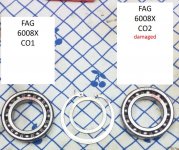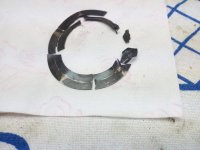quarkgluonplasma
Aluminum
- Joined
- Feb 2, 2017
- Location
- Zurich Switzerland
Hey folks
The following pictures stem from a Deckel FP1 vertical milling head (machine serial 28564, head serial 50114, manufactured/assembled 1950 A.D.). The head emits a unhealthy, crunching sound, even if running on low rpm (e.g. spindle turned by hand).


After disassembly the source of trouble could be tracked down to the following bearing (supporting the bevel gear).

Here a view of the whole train of elements from which the bearing comes. Left to right corresponds to bottom to top when assembled.

Since this is going to be my first machine tool bearing replacement and I would like to support the old lady at its best, advice and guidance is seeked herewith. We can go slowly, no need for a rush. Any input, even if commonly considered trivial, is highly appreciated.
Anyway, for me there are already these questions:
1. What would be the correct contemporary replacement for the noisy ********* 6008X CO2?
(maybe https://www.brw.ch/1/BRW-ToolShop/1...c-43be-a624-a0ca3973593c&pOnlyPromotion=False or better the 2Z version Werkzeuge, Normteile, Arbeitsschutz - Brutsch/Ruegger Tools, Schweiz - Einreihige Rillenkugellager SKF 2Z, mit Deckscheiben auf beiden Seiten)
2. What is the issue with this bearing anyway?
(despite close examination from the outside there are no missing parts or broken balls, why is it making that noise?)
3. What is the difference between the two bearings of the bevel gear ********* 6008X CO1 and ********* 6008 CO2?
Looking forward to receiving your thoughts,
best, Stefan
The following pictures stem from a Deckel FP1 vertical milling head (machine serial 28564, head serial 50114, manufactured/assembled 1950 A.D.). The head emits a unhealthy, crunching sound, even if running on low rpm (e.g. spindle turned by hand).


After disassembly the source of trouble could be tracked down to the following bearing (supporting the bevel gear).

Here a view of the whole train of elements from which the bearing comes. Left to right corresponds to bottom to top when assembled.

Since this is going to be my first machine tool bearing replacement and I would like to support the old lady at its best, advice and guidance is seeked herewith. We can go slowly, no need for a rush. Any input, even if commonly considered trivial, is highly appreciated.
Anyway, for me there are already these questions:
1. What would be the correct contemporary replacement for the noisy ********* 6008X CO2?
(maybe https://www.brw.ch/1/BRW-ToolShop/1...c-43be-a624-a0ca3973593c&pOnlyPromotion=False or better the 2Z version Werkzeuge, Normteile, Arbeitsschutz - Brutsch/Ruegger Tools, Schweiz - Einreihige Rillenkugellager SKF 2Z, mit Deckscheiben auf beiden Seiten)
2. What is the issue with this bearing anyway?
(despite close examination from the outside there are no missing parts or broken balls, why is it making that noise?)
3. What is the difference between the two bearings of the bevel gear ********* 6008X CO1 and ********* 6008 CO2?
Looking forward to receiving your thoughts,
best, Stefan



